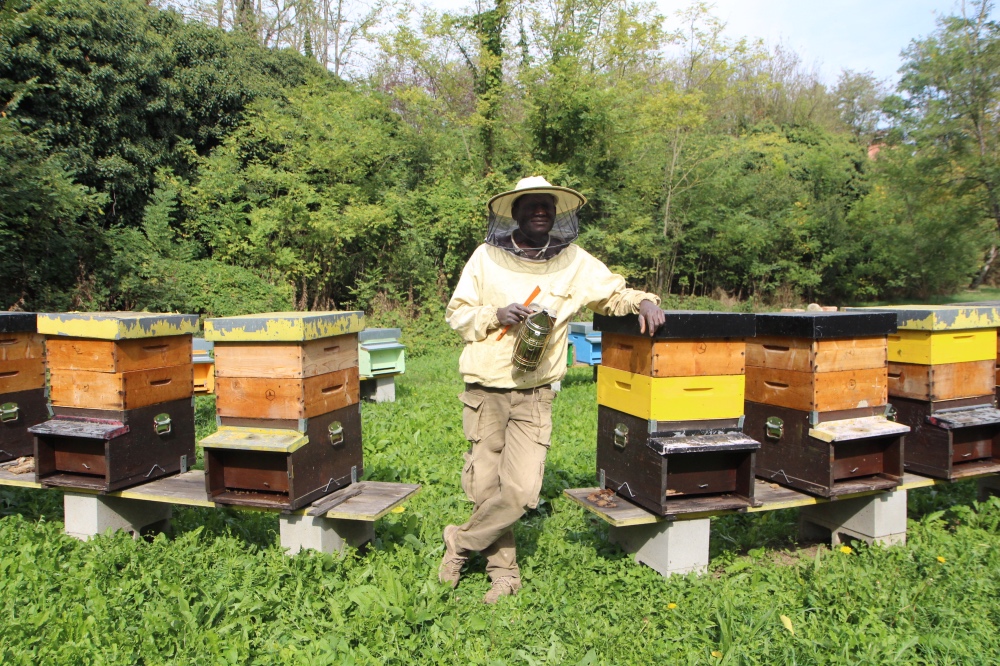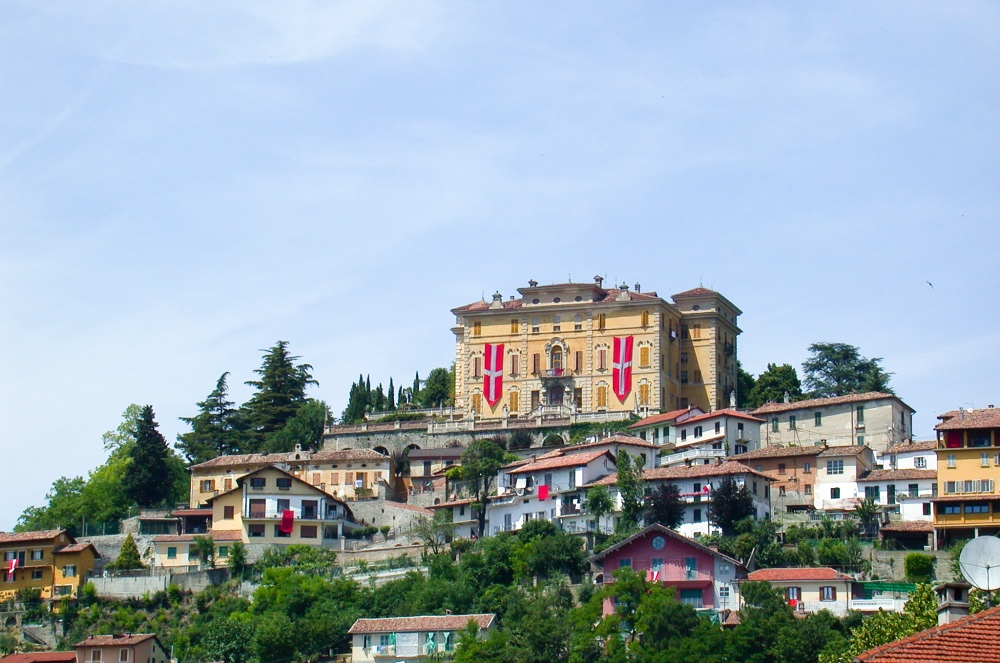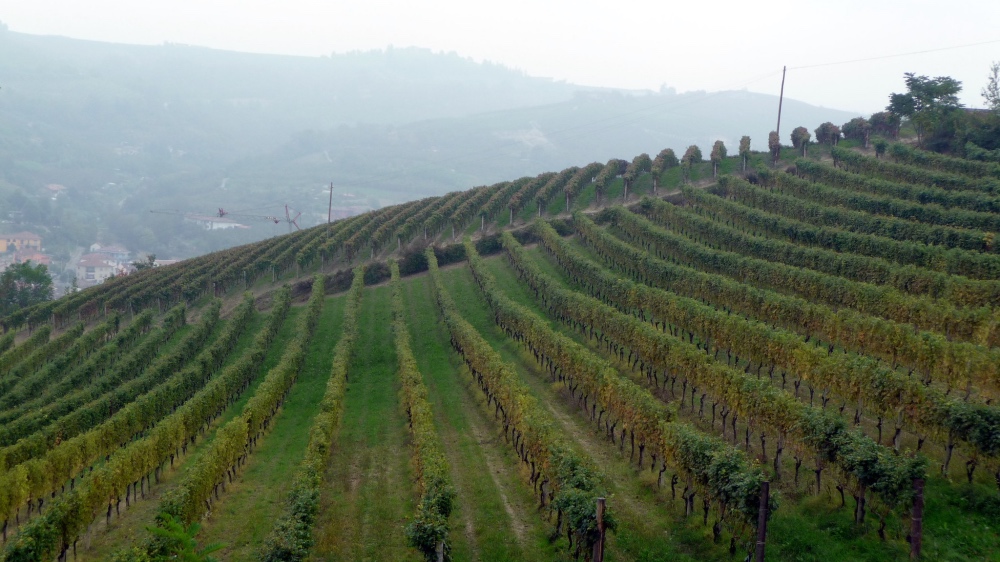
THIN LEI WIN, of Thomson Reuters Foundation, reports on how migrants are involved in keeping alive the country’s agricultural and culinary heritage which those who oppose their presence take so much pride in…
Canelli, Italy
Thomson Reuters Foundation
After carefully checking bunches of succulent, dark-skinned grapes native to Italy’s Piedmont wine region, Alhagie Jallow – who arrived from Gambia five years ago – nodded in approval.
Jallow, 32, had never set eyes on a vineyard until 2015 when he started working for Maramao, a 25 hectare organic farm, which grows grapes for the sparkling dessert wines and heady, full bodied reds for which the northwestern region is famous.
Now he teaches other migrants about organic farming, including how to grow and harvest ancient grains like spelt and ottofile – which is used to make polenta, a staple of northern Italy – at Maramao.

Abdul Sane, from Senegal, poses for a portrait at an apiary in Alessandria, a town n Piedmont region in north-western Italy, on 4th October. PICTURE: Thomson Reuters Foundation/Thin Lei Win
“We have so many brothers, I think about 70, who came here and learnt this work for two months, six months. I never see somebody leave here without a job,” Jallow said proudly.
Jallow arrived in Italy by sea, like millions of migrants who have landed on European shores since 2015, triggering a crisis that has sowed bitter divisions among European states, strained social and security services and boosted populism.
“In this famous wine region, without migrants from Eastern Europe or Africa, the grapes would stay on the vines.”
– Davide Colleoni, co-founder of Maramao, which aims to both help refugees and asylum seekers and keep the land productive.
The influx fuelled the rise of Italy’s far-right, anti-migrant League party, led by Matteo Salvini, who in 2018 banned ships carrying illegal migrants from docking at Italian ports and bulldozed refugee camps.
While Salvini has warned that mass immigration has spawned criminality and drug abuse, many newcomers – like Jallow – are keeping alive the country’s agricultural and culinary heritage that nationalists take so much pride in.
Amid rising racism – from online hate speech to football fans subjecting black players to monkey chants – many Italian farmers, who are desperate for labour, have welcomed migrants.
“In this famous wine region, without migrants from Eastern Europe or Africa, the grapes would stay on the vines,” said Davide Colleoni, co-founder of Maramao, which aims to both help refugees and asylum seekers and keep the land productive.
Famed for its food and wine, Italy has one of Europe’s largest agricultural sectors but its farmers are ageing. The number of farms more than halved to one million in 2013 from 2.4 million in 2000, according to European Union data.
Since its inception, Maramao has more than doubled in size by renting farmland from elderly locals around Canelli, a small, medieval town known for its historic wine cellars, referred to in tourist brochures as “underground cathedrals”.
“These farmers are retired, their children are outside Italy or not interested in agriculture, but they don’t want to sell the land,” said Colleoni, who sells wine, jam and fresh produce in Maramao’s shop in the town centre and at farmers’ markets.
“So we keep it alive, we plant new trees…so if they want to sell in the future, they might even get a better price.”
Maramao has dozens of loyal customers, but is not yet breaking even as it takes years for newly planted vines to mature and produce wine, Colleoni said.

The medieval Piedmont town of Canelli – seen here in 2002 – which lies near the Maramao farm. PICTURE: Alessandro (licensed under CC BY-NC-ND 2.0)
Italy has a long tradition of relying on migrant labour, now from West Africa but previously from Eastern Europe, said Cesare Quaglia, a third-generation farmer in Asti, Piedmont.
“Before that, immigrants in Piedmont were Italians from southern Italy or even earlier, from Veneto,” said Quaglia, one of the few Italian farmers who still grow ottofile.
Iron-rich ottofile, which dates back to the 19th century, was a favourite of the Piedmontese royal family but abandoned after the Second World War in favour of higher-yielding, imported maize, Quaglia said.
“Because I’m Indigenous to this region, I want to grow Indigenous food in a traditional manner,” he said.
“People say, ‘We don’t want immigrants, they take our jobs’. But if you manage immigration and services well, you can work for the development of local community, for everybody.”
– said Alberto Mossino, founder of Villa Quaglina.
It is also important for biodiversity, he added, echoing UN Food and Agriculture Organization warnings that over-reliance on a limited number of crops risks global hunger if harvests fail.
For five years, he has hired about seven or eight refugees from Villa Quaglina – a former seminary which hosts about 50 people for up to a year each as their cases are assessed – to harvest and grind ottofile into polenta flour.
“People say, ‘We don’t want immigrants, they take our jobs,'” said Alberto Mossino, Villa Quaglina’s founder.
“But if you manage immigration and services well, you can work for the development of local community, for everybody.”
About 40 kilometres north-east is Alessandria where Senegalese refugee Abdul Sane trains other refugees and asylum seekers in beekeeping. Demand for traditional, hand-produced honey is growing, few people are willing to work with bees.
Cambalache, the non-profit that employs Sane, has trained 170 migrant beekeepers since 2015, most of whom have gone on to find jobs with Italian companies. The United Nations is helping it expand this model to other parts of Italy.

A vineyard in the Piedmont region of Italy, as seen in 2010. PICTURE: Blue moon in her eyes (licensed under CC BY 2.0)
Sane, a 36-year-old former electrician, initially balked at becoming a beekeeper because African bees can be deadly but now loves the job so much he teaches beekeeping to people back in Senegal via video calls.
The father-of-two said his job brings him peace of mind after a traumatic journey to Italy in 2014, where fellow travellers died and he was imprisoned in Libya.
“When I’m here alone, with the bees, it’s like psychological therapy,” said Sane, in a protected jacket, hat and veil and bare hands, as he headed to a small apiary that he called “my kingdom”.
Sane sends about €500 a month home to his wife and children and dreams of owning a company producing honey.
He is also learning to farm snails, a traditional delicacy in southern Italy, which Cambalache hopes could provide another avenue for migrants to find decent jobs.
Similarly, Jallow – the Gambian winegrower – was at first reluctant to become a farmer after enduring eight months in Libya, where he was threatened at gunpoint and put in informal detention.
Then he saw the vineyards.
“Being inside it, I felt something in my heart. It was one of the happiest days in my life, knowing I’m going to learn something completely new,” he recalled.
He still faces discrimination, like one local who always mistakes him for a drug dealer, a supermarket cashier surprised by his honesty in pointing out the bill was too low and locals who praise him by saying he is “not like the others”.
The two West Africans are lucky. Many migrants work in terrible conditions, labour experts say.
“Thousands of migrants and refugees are employed like ghosts in restaurants and hotels, in the fields, in food companies,” said Massimo Gnone, an integration expert with the UN refugee agency, UNHCR, in Italy.
“Often their presence is kept hidden, almost forgotten.”





